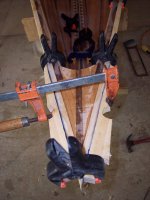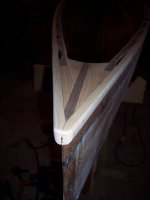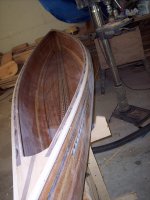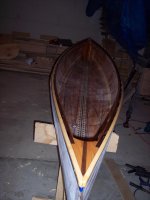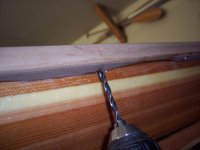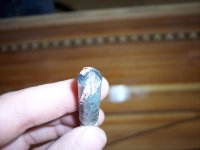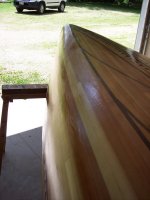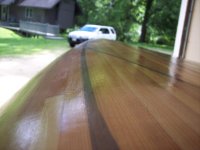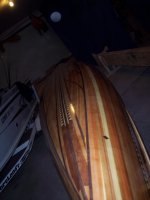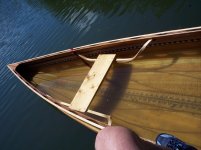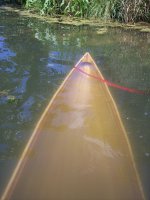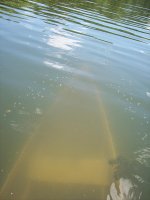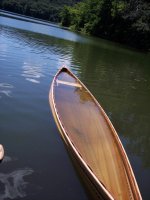Alan Gage Turns out, that was the worst part for me as well - keeping a wet edge. I did the interior with the doors closed, and was sprinkling water on the concrete floor to boost humidity. Thinned the stuff by 30%, which is the absolute max that SystemThree recommends. I've enough leftovers for another couple of coats, if I decide to try to improve the finish. Sounds like people who are using the pigmented version usually go up to five coats, and then use automotive buffing compounds, etc. I've got too many glass imperfections for that to be worthwhile.
I'm calling the build done, even though I still have things to work on. (and redo - some of that will get its own thread) The hull is finished, and I can paddle it.
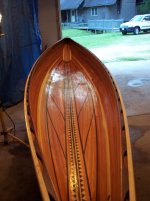
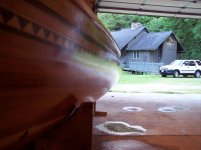
Inside coat while fresh, and the outside from a low angle. The amber tint is due to the halogen lights that I had running in the background.
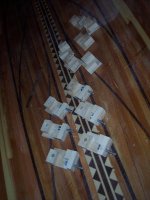
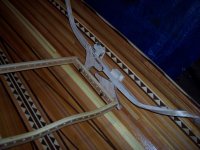

And this is what all the fuss with the various laminated and mystery parts was about. The blocks slide on the rails, and have a bushing embedded like the seat frames. Please excuse the fact that they have no finish and that the bent laminations in particular are sort of ugly. They were a prototype that did not turn out as well as I had hoped, and are on the list to be replaced. The weird shapes allow this seat, in theory, to pivot to an upper position or a lower one, and to remain stable in either.
Even this was not without its wrinkles, though.
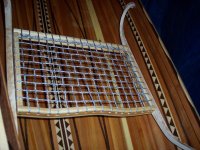
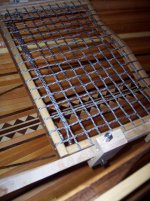
The slide frames near one end were mounted about 4" closer to the stem than I had intended. This narrowed the space between the rails so that there was not room for the pivot. I ended up mounting like this - I still have some height adjustment, if I pull the blocks and turn them upside down. This allows me about 2" adjustment.
All loaded up and ready to ride:


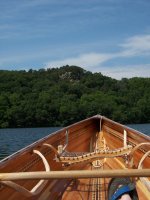
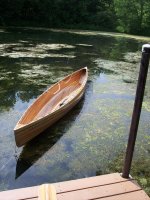
Just went down to the local state park. Fairly successful test paddle, managed to sunburn myself. Notice anything wrong?
This paddle, I went without any gear other than the safety stuff. In reviewing my notes from the design stage, I'd kind of figured that 200#, boat, paddler and gear was the minimum for performance. All things considered, I had maybe 195#. This is too light, the canoe was rather skittish with a breeze. That, or I need more practice handling a canoe solo.
Numbers wise, the hull, slide rails, and one seat came out right at 50#
There is no thwart installed, as I intended the center seat to stiffen things a bit. I did include threaded inserts in the gunwale for a thwart in the middle cary position, and may add one as an "Option" so that I can reconfigure depending on what I am doing that day.
The Knuckled tumblehome worked out great. I was able to hit-and-switch right across the widest part of the beam with no trouble. It was not even a stretch.
I experimented a bit with "Canadian Style" This needs more work for me. (I had forgotten that many of the examples I have seen have the paddler's inside leg extended in front of him, and with both feet under me, I was having issues controlling my roll)
I also was able to stand for short periods. Not something that I would want to duplicate in wind or current, but then I will normally have a partner or more gear along, which should stabilize things. I also found that sitting very low, 2 1/2" boat cushion on the bottom, is not a good paddling station for me.
